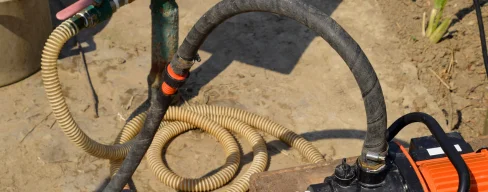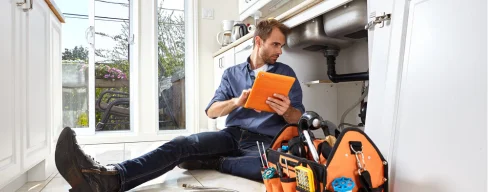Overview and Importance
Retaining walls, which are crucial elements of architectural design serving aesthetic and functional purposes alike, rely heavily on their drainage systems to ensure stability amidst several other factors.
A well-designed drainage system, typically including a pipe for retaining wall, is crucial as it shields the wall against potential pressure from accumulated water. If left unattended, this pressure can compromise the structural stability of the wall. The implementation of such a system notably alleviates concerns in regard to weakened infrastructure caused by external moisture build-up.
In this article, we will delve into the significance of drainage for retaining wall and provide a detailed breakdown of its various aspects. We shall investigate the workings of a retaining wall drainage pipe and how it obstructs small particles from entering the system. Upon completion, you should have an extensive understanding as to why having proper drainage is crucial whether constructing a new or renovating an existing retaining wall.
Retaining Wall Drainage: Its Significance and Necessity
The outcomes of inadequate drainage
Inadequate drainage for retaining wall can lead to serious consequences. If surface water is not effectively diverted from the structure, it may collect and saturate the soil behind it. As a result, pressure against the wall increases laterally and could cause leaning, cracking or even collapse. This poses significant safety risks as well as aesthetic issues, especially for taller walls that prove more dangerous when compromised in this manner.
The advantages of an efficient drainage system
Alternatively, utilizing a retaining wall drainage pipe can significantly improve the longevity of retention walls by facilitating effective drainage. This process involves removing excess groundwater from the structure to prevent soil saturation and pressure build-up that may cause deformation or failure over time. As such, implementing proper draining systems drastically minimizes costly repairs and reconstruction efforts for these structures.
Ensuring efficient drainage for a retaining wall not only guarantees its structural stability, but also protects against soil erosion and upholds the environmental health of the surrounding area. Consequently, proper investment in drainage is crucial to ensure long-lasting durability and aesthetic appeal for any retaining wall.
Drainage Pipe for Retaining Walls: Types
The durability and efficacy of your retaining wall drainage pipe primarily hinge on its composition. PVC pipes are a budget-friendly, enduring choice that is frequently favored. Although flexible enough to withstand significant soil pressure, corrugated plastic pipes have shorter lifespans than perforated metal alternatives renowned for their robustness and longevity.
Dimensions and Breathability
Another important consideration is the retaining wall drainage pipe size. A buildup of water behind the wall might result from a pipe that is too small because it cannot control the water flow adequately. On the other hand, a too-huge pipe might raise the expense of the project needlessly. Perforated pipes enable water to flow in from the surrounding soil, substantially lowering soil saturation.
This is another important feature of the pipe: permeability. To preserve the structural integrity and lifespan of the retaining wall, make sure that the pipe’s size and permeability match the requirements of the wall when it is built.
Installation Techniques for Retaining Wall Drainage System: Best Practice
Install Methods
Site Preparation: Look over the site, clean up any trash, and mark where the drains will go.
Pipe Selection: Pick the right drainage pipe based on the water flow and the weather.
Foundation and Trenching: Dig a trench and lay non-woven geotextile fabric over it to keep dirt from getting in.
Installing the Drainage Pipe for Retaining Wall: Put the pipe in place with a small slope so that water can flow smoothly, and then cover it with gravel.
Backfilling: Put gravel in the hole and pack it down firmly to keep the pipes from getting damaged.
Make sure the system was installed correctly and try it.
Troubleshooting Common Issues
Poor Water Flow: Adjust the pipe gradient if water doesn’t flow correctly.
Pipe Clogging: Use coarse gravel and proper geotextile fabric; regularly clear the pipe inlet and outlet.
Water Accumulation: Increase drainage capacity if water accumulates behind the wall.
Drainage Pipe for Retaining Wall Damage During Backfilling: Use hand tools near the pipe and avoid sharp rocks in backfill material.
Maintaining and repairing drainage systems for retaining walls
Proper maintenance of drainage systems for retaining walls is vital to ensure their longevity and functionality. To uphold routine upkeep, the following checklist should be followed:
Inspections should be carried out regularly to identify any obvious signs of damage or blockage. This is particularly important every six months, especially after heavy rainfall.
Remove debris such as leaves and dirt that can obstruct the drains. Additionally, ensure that the drain wall pipe’s visible parts are checked for cracks, breaks, and other indications of wear.
When inspecting retaining walls look for water pools or damp spots since this may indicate issues requiring attention.
It’s vital to maintain gravel filters by frequently washing them around pipes in order to keep them working properly.
To prevent significant repairs from arising deal with problems promptly when they arise using these steps:
Water Pooling: The accumulation of water at the wall’s base may indicate a blockage. Ensure that drainage holes are unobstructed. It’s an easy way to understand if you have good retaining wall or not
Moist Walls: Exterior walls that remain damp imply poor drainage. Consider hiring an expert to assess and enhance the system if necessary.
Sediment Accumulation: When debris builds up in drain pipes, it impairs their efficiency. If you detect sediment in your setup, flush it out immediately.
Pipe Damage or Fractures: Timely repair is essential when cracks or breaks appear along your plumbing network as they hinder adequate draining processes.
Consistent care and rapid remediation of any malfunction can maintain optimal security measures for retaining walls’ stability and longevity through proper functioning of its drainage infrastructure.
Best Practices and Final Remarks
The critical importance of effective drainage systems in ensuring the longevity and stability of retaining walls is thoroughly examined in this article. Essential points to note are:
Proper drainage holds significant importance in preventing water damage and maintaining the structural stability of retaining walls.
Picking the Correct Drainage Pipe: To make an apt choice, account for material, size and environmental elements that match with your retaining wall’s precise requirements.
To summarize, the proper selection of materials, precise drain installation techniques, and consistent maintenance are crucial for ensuring effective drainage in a retaining wall. By following these recommended standards, you can safeguard your property investment while prolonging the life expectancy and stability of your structure.
Contact Details
Email: info@drainexpress.ca
Phone:
+1 416 752 5959
Our Location
300 New Toronto St #14,
Etobicoke, ON, M8V 2E8
24/h Customer Service
We are open 24/7
Contact us at any time

